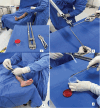[Analysis of Microbiological Findings on the Surface of External Fixator Pins Comparing Steel Pins with Hydroxyapatite-Coated Pins]
- PMID: 40552005
- PMCID: PMC12185183
- DOI: 10.1055/s-0045-1809519
[Analysis of Microbiological Findings on the Surface of External Fixator Pins Comparing Steel Pins with Hydroxyapatite-Coated Pins]
Abstract
Objective: To compare the microbial retrieval rates and the organism types on the surface of stainless-steel pins (SSPs) and hydroxyapatite-coated pins (HCPs) from external fixators (EFs).
Methods: The present prospective, non-randomized, multicenter, comparative interventional cohort study occurred from April 2018 to October 2021. The sample consisted of 44 patients with EFs, including 33 with SSPs and 11 with HCPs. We collected two pins from each patient, the one with the best and the one with the worst clinical appearance according to the Maz-Oxford-Nuffield (MON) classification, in an aseptic manner, and sent them for microbiological analysis.
Results: The overall superficial infection (SI) rate was 52.3% (23 of 44 patients), affecting 45.5% (5 of 11) patients with HCPs and 54.5% (18 of 33) patients with SSPs ( p = 0.732). Of the 88 pins, 43.2% (38 of 88 pins) yielded microbial identification, with 42 pathogens isolated. Staphylococcus aureus was the most frequent organism, accounting for 59.5% (25 of 42 pathogens) of the positive samples. In the best-looking pins, the microbial retrieval rate was significantly lower in HCPs than SSPs, with 18.2% (2 pathogens in 11 pins) and 45.5% (15 pathogens in 33 pins), respectively ( p = 0.036). In the worst-looking pins, the microbial retrieval rate in HCPs and SSPs was 27.3% (3 pathogens in 11 pins) and 54.5% (18 pathogens in 33 pins), respectively ( p = 0.036).
Conclusion: Microbial retrieval rates were lower in HCPs than in SSPs. However, these differences did not impact clinical infection rates, which were similar in both groups.
Objetivo: Comparar as taxas de recuperação microbiana e os tipos de microrganismos identificados na superfície dos pinos de aço inoxidável (PAIs) e nos pinos revestidos com hidroxiapatita (PHAs) de fixadores externos (FEs).
Métodos: Este estudo de coorte prospectiva de intervenção, não randomizado, multicêntrico, comparative foi realizado entre abril de 2018 e outubro de 2021, com 44 pacientes tratados com FE, 33 dos quais receberam PAIs e 11 receberam PHAs. Foram coletados e enviados para análise microbiológica dois pinos de cada paciente, o de melhor e o de pior aspecto clínico conforme a classificação de Maz-Oxford-Nuffield (MON), de forma asséptica.
Resultados: A taxa de infecção (TI) superficial global foi de 52,3% (23 de 44 pacientes), sendo 45,5% (5 de 11 pacientes) entre pacientes que receberam PHAs e 54,5% (18 de 33 pacientes) entre pacientes que receberam PAIs, respectivamente ( p = 0,732). Dos 88 pinos, 43,2% (38 de 88 pinos) apresentaram identificação microbiana, sendo isolados 42 patógenos no total. O Staphylococcus aureus foi o mais frequente, representando 59,5% (25 dos 42 patógenos). Nas amostras de “melhor aspecto,” a taxa de recuperação microbiana foi significativamente menor nos PHAs do que nos PAIs, 18,2% (2 patógenos em 11 pinos) e 45,5% (15 patógenos em 33 pinos), respectivamente ( p = 0,036). Nas amostras de “pior aspecto,” a taxa de recuperação microbiana nos PHAs se nos PAIs foi 27,3% (3 patógenos em 11 pinos) e 54,5% (18 patógenos em 33 pinos), respectivamente ( p = 0,036).
Conclusão: As taxas de recuperação microbiana foram menores nos PHAs comparadas às dos PAIs. Entretanto, estas diferenças não impactaram nas taxas de infecção clínica, que foram semelhantes nos dois grupos.
Keywords: bone nails; bone wires; external fixators; hydroxyapatite; infections.
The Author(s). This is an open access article published by Thieme under the terms of the Creative Commons Attribution 4.0 International License, permitting copying and reproduction so long as the original work is given appropriate credit ( https://creativecommons.org/licenses/by/4.0/ ).
Conflict of interest statement
Conflito de Interesses Os autores não têm conflito de interesses a declarar.
Figures
Similar articles
-
Analysis of Microbiological Findings on the Surface of External Fixator Pins Comparing Steel Pins with Hydroxyapatite-Coated Pins.Rev Bras Ortop (Sao Paulo). 2025 Jun 23;60(2):1-7. doi: 10.1055/s-0045-1809337. eCollection 2025 Apr. Rev Bras Ortop (Sao Paulo). 2025. PMID: 40551995 Free PMC article.
-
Systemic pharmacological treatments for chronic plaque psoriasis: a network meta-analysis.Cochrane Database Syst Rev. 2021 Apr 19;4(4):CD011535. doi: 10.1002/14651858.CD011535.pub4. Cochrane Database Syst Rev. 2021. Update in: Cochrane Database Syst Rev. 2022 May 23;5:CD011535. doi: 10.1002/14651858.CD011535.pub5. PMID: 33871055 Free PMC article. Updated.
-
Initial arch wires used in orthodontic treatment with fixed appliances.Cochrane Database Syst Rev. 2018 Jul 31;7(7):CD007859. doi: 10.1002/14651858.CD007859.pub4. Cochrane Database Syst Rev. 2018. Update in: Cochrane Database Syst Rev. 2024 Feb 06;2:CD007859. doi: 10.1002/14651858.CD007859.pub5. PMID: 30064155 Free PMC article. Updated.
-
Population-based interventions for reducing sexually transmitted infections, including HIV infection.Cochrane Database Syst Rev. 2004;(2):CD001220. doi: 10.1002/14651858.CD001220.pub2. Cochrane Database Syst Rev. 2004. Update in: Cochrane Database Syst Rev. 2011 Mar 16;(3):CD001220. doi: 10.1002/14651858.CD001220.pub3. PMID: 15106156 Updated.
-
Systemic pharmacological treatments for chronic plaque psoriasis: a network meta-analysis.Cochrane Database Syst Rev. 2017 Dec 22;12(12):CD011535. doi: 10.1002/14651858.CD011535.pub2. Cochrane Database Syst Rev. 2017. Update in: Cochrane Database Syst Rev. 2020 Jan 9;1:CD011535. doi: 10.1002/14651858.CD011535.pub3. PMID: 29271481 Free PMC article. Updated.
References
Publication types
LinkOut - more resources
Full Text Sources
Miscellaneous


